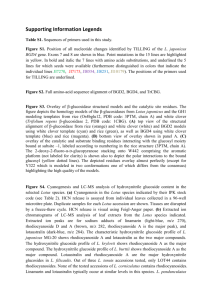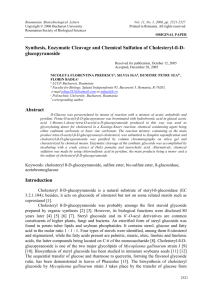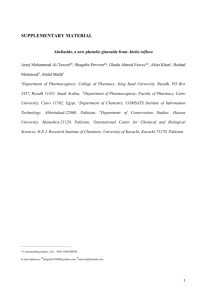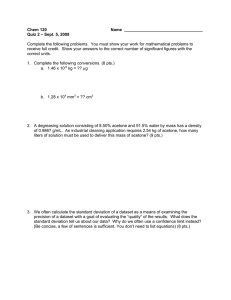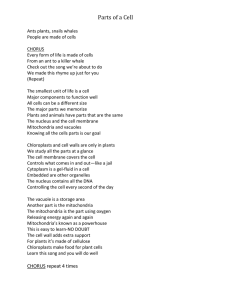The Biosynthesis Steryl Glucosides Plants'
advertisement
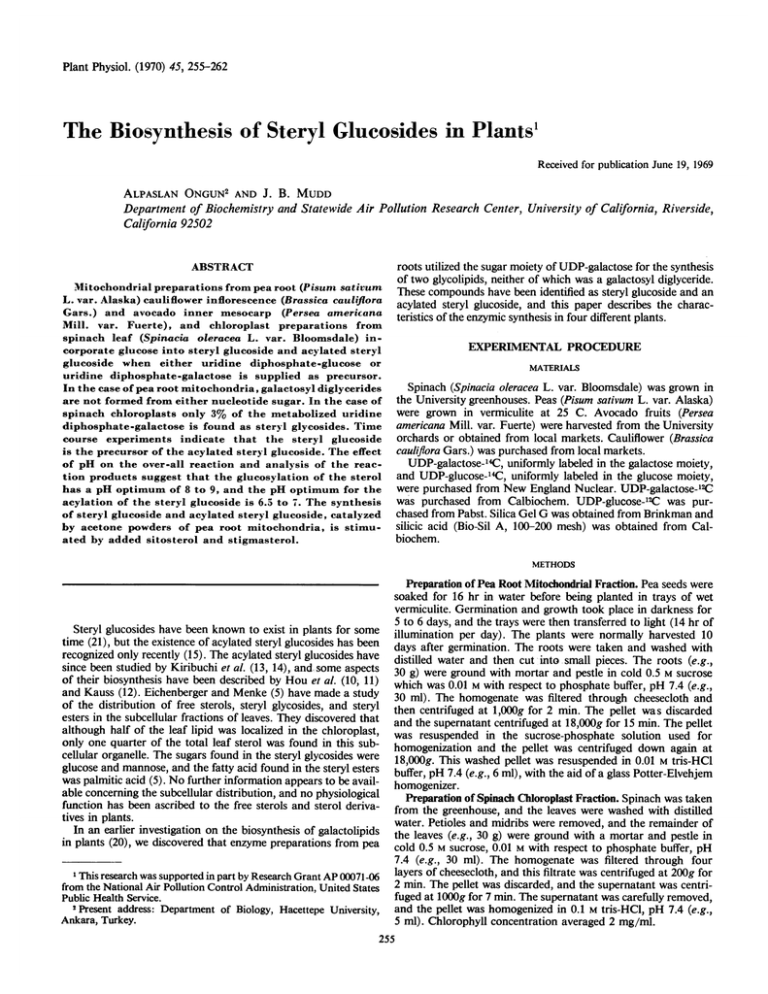
Plant Physiol. (1970) 45, 255-262 The Biosynthesis of Steryl Glucosides in Plants' Received for publication June 19, 1969 ALPASLAN ONGUN2 AND J. B. MUDD Department of Biochemistry and Statewide Air Pollution Research Center, University of California, Riverside, California 92502 roots utilized the sugar moiety of UDP-galactose for the synthesis of two glycolipids, neither of which was a galactosyl diglyceride. These compounds have been identified as steryl glucoside and an acylated steryl glucoside, and this paper describes the characteristics of the enzymic synthesis in four different plants. ABSTRACT Mitochondrial preparations from pea root (Pisunt sativum L. var. Alaska) cauliflower inflorescence (Brassica cauliflora Gars.) and avocado inner mesocarp (Persea americana Mill. var. Fuerte), and chloroplast preparations from spinach leaf (Spinacia oleracea L. var. Bloomsdale) incorporate glucose into steryl glucoside and acylated steryl glucoside when either uridine diphosphate-glucose or uridine diphosphate-galactose is supplied as precursor. In the case of pea root mitochondria, galactosyl diglycerides are not formed from either nucleotide sugar. In the case of spinach chloroplasts only 3% of the metabolized uridine diphosphate-galactose is found as steryl glycosides. Time course experiments indicate that the steryl glucoside is the precursor of the acylated steryl glucoside. The effect of pH on the over-all reaction and analysis of the reaction products suggest that the glucosylation of the sterol has a pH optimum of 8 to 9, and the pH optimum for the acylation of the steryl glucoside is 6.3 to 7. The synthesis of steryl glucoside and acylated steryl glucoside, catalyzed by acetone powders of pea root mitochondria, is stimuated by added sitosterol and stigmasterol. EXPERIMENTAL PROCEDURE MATERIALS Spinach (Spinacia oleracea L. var. Bloomsdale) was grown in the University greenhouses. Peas (Pisum sativum L. var. Alaska) were grown in vermiculite at 25 C. Avocado fruits (Persea americana Mill. var. Fuerte) were harvested from the University orchards or obtained from local markets. Cauliflower (Brassica cauliflora Gars.) was purchased from local markets. UDP-galactose-'4C, uniformly labeled in the galactose moiety, and UDP-glucose-l4C, uniformly labeled in the glucose moiety, were purchased from New England Nuclear. UDP-galactose-'2C was purchased from Calbiochem. UDP-glucose-12C was purchased from Pabst. Silica Gel G was obtained from Brinkman and silicic acid (Bio-Sil A, 100-200 mesh) was obtained from Calbiochem. METHODS Steryl glucosides have been known to exist in plants for some time (21), but the existence of acylated steryl glucosides has been recognized only recently (15). The acylated steryl glucosides have since been studied by Kiribuchi et al. (13, 14), and. some aspects of their biosynthesis have been described by Hou et al. (10, 11) and Kauss (12). Eichenberger and Menke (5) have made a study of the distribution of free sterols, steryl glycosides, and steryl esters in the subcellular fractions of leaves. They discovered that although half of the leaf lipid was localized in the chloroplast, only one quarter of the total leaf sterol was found in this subcellular organelle. The sugars found in the steryl glycosides were glucose and mannose, and the fatty acid found in the steryl esters was palmitic acid (5). No further information appears to be available concerning the subcellular distribution, and no physiological function has been ascribed to the free sterols and sterol derivatives in plants. In an earlier investigation on the biosynthesis of galactolipids in plants (20), we discovered that enzyme preparations from pea Preparation of Pea Root Mitochondrial Fraction. Pea seeds were soaked for 16 hr in water before being planted in trays of wet vermiculite. Germination and growth took place in darkness for 5 to 6 days, and the trays were then transferred to light (14 hr of illumination per day). The plants were normally harvested 10 days after germination. The roots were taken and washed with distilled water and then cut -into small pieces. The roots (e.g., 30 g) were ground with mortar and pestle in cold 0.5 M sucrose which was 0.01 M with respect to phosphate buffer, pH 7.4 (e.g., 30 ml). The homogenate was filtered through cheesecloth and then centrifuged at 1,OOOg for 2 min. The pellet was discarded and the supematant centrifuged at 18,000g for 15 min. The pellet was resuspended in the sucrose-phosphate solution used for homogenization and the pellet was centrifuged down again at 18,000g. This washed pellet was resuspended in 0.01 M tris-HCl buffer, pH 7.4 (e.g., 6 ml), with the aid of a glass Potter-Elvehjem homogenizer. Preparation of Spinach Chloroplast Fraction. Spinach was taken from the greenhouse, and the leaves were washed with distilled water. Petioles and midribs were removed, and the remainder of the leaves (e.g., 30 g) were ground with a mortar and pestle in cold 0.5 M sucrose, 0.01 M with respect to phosphate buffer, pH 7.4 (e.g., 30 ml). The homogenate was filtered through four layers of cheesecloth, and this filtrate was centrifuged at 200g for 2 min. The pellet was discarded, and the supernatant was centrifuged at lOOOg for 7 min. The supernatant was carefully removed, and the pellet was homogenized in 0.1 M tris-HCl, pH 7.4 (e.g., 5 ml). Chlorophyll concentration averaged 2 mg/ml. 1 This research was supported in part by Research Grant AP 00071-06 from the National Air Pollution Control Administration, United States Public Health Service. 2Present address: Department of Biology, Hacettepe University, Ankara, Turkey. 255 256 Preparation of Cauliflower Mitochondrial Fraction. Cauliflower inflorescence was separated from stem material and passed through a kitchen grater. The grated material (e.g., 20 g) was ground in a mortar and pestle with sucrose-phosphate and centrifuged as described for the preparation of the pea root mitochondrial fraction. The mitochondrial pellet was rehomogenized in 0.1 M tris-HCl, pH 7.4 (e.g., 4 ml). Protein concentration was 8 to 10 mg,'ml. Preparation of Avocado Mitochondrial Fraction. The avocado fruit at the stage of ripeness, i.e., soft to the touch, was peeled, and the seed was removed. The outer, chlorophyllous, mesocarp was removed and discarded. The remainder of the mesocarp was ground in a mortar and pestle with 0.5 M sucrose-0.01 M phosphate, pH 7.4. The homogenate was filtered through cheesecloth and the filtrate was centrifuged at 2,000g for 10 min. The layer between the pellet and the floating fat layer was drawn off by suction and recentrifuged at 20,000g for 15 min. The supernatant was carefully removed, and the pellet was resuspended in 0.1 M tris-HCl, pH 7.5. Protein concentration was 6 to 10 mg/ml. Chlorophyll concentration was less than 0.01 mg/ml. Reaction Conditions. Radioactive UDP-galactose or UDPglucose or both were incubated with the enzyme source and buffer (normally tris-HCl, pH 7.5) for 60 min at 30 C in glass-stoppered centrifuge tubes. At the end of the reaction period the reaction mixture was extracted according to the procedure of Bligh and Dyer (2). The incorporation of hexose into lipid was measured by taking an aliquot of the chloroform layer and measuring its radioactivity in either a thin window gas flow counter (NuclearChicago) or a liquid scintillation counter (Nuclear-Chicago). Preparation of Acetone Powder of Pea Root Mitochondria. Mitochondria were prepared from 300 g of pea roots as described above. The mitochondrial preparation in 9 ml of 0.1 M tris-HCl, pH 7.5, was added dropwise to 81 ml of stirred acetone at -20 C. The suspension was filtered by use of a Buchner funnel with suction, and the powder was then transferred to a desiccator and stored under vacuum at -20 C. The dried powder weighed 300 mg. For enzymic assay the acetone powder was suspended in 0.05 M tris-HCl, pH 7.5: 20 mg of acetone powder per ml of buffer. When lipids were added back to the acetone powder, the procedure followed was that described previously (20); that is, an acetone solution of the lipid was added to the dry acetone powder, and the acetone was removed in a nitrogen stream. Separation of Lipids. Lipids were separated by two-dimensional thin layer chromatography on 20- X 20-cm glass plates spread with Silica Gel G and activated at 110 C. Plates were developed in chloroform-methanol-7 N NH40H (65:30:4) in the first direction and in chloroform-methanol-acetic acid-water (170:25:25:6) in the second direction. Radioactive areas were located by radioautography, and these areas were then scraped off for radioactivity counting. Analytical Methods. Protein was determined by the method of Lowry et al. (16). Chlorophyll was determined by the method of Arnon (1). The Liebermann-Burchard reaction was performed according to the directions of Cook (3). Nonspecific detection of compounds separated on thin layer silica gel plates was by charring after spraying with 55% aqueous H2SO4 (v/v) containing 0.6%c, K2Cr2O7. Sugars were detected by spraying with an anilinediphenylamine-phosphoric acid reagent (22). Sugars were detected in hydrolysates of the steryl glycosides by the method of Dubois et Plant Physiol. Vol. 45, 1970 ONGUN AND MUDD al. (4). RESULTS Identification of Steryl Glucoside and Acylated Steryl Glucoside. Radioactive steryl glucoside and acylated steryl glucoside were prepared by incubation of a pea root mitochondrial prepara- 06 ASG - U O0. 2 0 -2%/CH30H 2 4 in CHCI3-±-5%/CH30H 6 8 Fraction 10 12 -in 14 CHC13 16 Number FIG. 1. Separation of steryl glucoside and acylated steryl glucoside by column chromatography. Radioactive steryl glucosides were prepared by incubating 1 Ac (_ 4 m,Amoles) of UDP-galactose-14C with pea root mitochondria prepared from 25 g of pea roots for 60 min at 30 C in a reaction mixture 0.1 M with respect to tris-HCl, pH 7.5, in a reaction volume of 0.8 ml. The lipid fraction was extracted, and one quarter was mixed with 300 mg of lipid extracted from mitochondria isolated from 600 g of cauliflower inflorescence. The lipid was then fractionated as described in the text. Abbreviations in this and other figures: ASG: acylated steryl glucoside; SG: steryl glucoside; MG: monogalactosyl diglyceride; DG: digalactosyl diglyceride; TG: trigalactosyl diglyceride. tion with UDP-galactose as described in "Experimental Procedure." In the experiment shown in Figure 1, the radioactive lipid (40,000 cpm) was added to 300 mg of lipid extracted from cauliflower mitochondria to act as carrier. The lipid mixture was taken through a preliminary purification procedure by chromatographing it on a silicic acid column (1.2 X 24 cm), washing the nonradioactive lipids off first with 50 ml chloroform. Elution was continued with 10%c methanol in chloroform, and 10-ml fractions were collected. The radioactive steryl glucoside and acylated steryl glucoside were eluted in fractions 3 to 5 (30-50 ml), and the major parts of the phospholipids were left on the column. Recovery in this step was quantitative. The radioactive samples were combined and concentrated and added to a multibore column (7) having the dimensions 15 X 0.8, 15 x 0.6, and 15 X 0.4 cm. This column contained 6 g of silicic acid. Elution was started with methanol-chloroform, 2:98, v/v, and fractions were collected for 40 ml. The elution solvent was changed to methanol-chloroform, 5:95, v/v, for 30 ml. The elution sequence and radioactivity as determined on aliquots of the fractions are shown in Figure 1. Both samples gave a positive Liebermann-Burchard test indicating the presence of sterol. Both samples contained the radioactive sugar. The sugar component was released by hydrolysis in N methanolic HCI (50:50, v/v) for 60 min at 100 C and chromatographed on paper in the solvent system phenol-H20 (100:38, v/v). The sugar was always found to be glucose regardless of the supply of UDP-glucose or UDP-galactose to pea root mitochondria. When the samples obtained from the column were subjected to alkaline hydrolysis in 0.2 N NaOH in 90% methanol for 2 hr at 40 C, the compound eluted from the column with 2% methanol in chloroform was converted to a compound chromatographically indistinguishable from the compound eluted from the column with 5S%U methanol in chloroform. The latter compound was not changed by mild alkaline hydrolysis. These results indicate the former compound to be acylated steryl glucoside and the latter to be steryl glucoside. A sample from the acylated steryl glucoside Plant Physiol. Vol. 45, 1970 257 BIOSYNTHESIS OF STERYL GLUCOSIDES Table I. Utilization of UDP-Glucose and UDP-Galactose int Lipid Synthesis by Different Planit Preparations Reaction conditions: Experiment 1: Reaction mixture (in duplicate) contained 0.6 ml of avocado mitochondrial suspension (3.8 mg of protein), 1 mumole of UDP-galactose-'4C (24,000 cpm) or 1 m,umole of UDP-glucose-14C (22,000 cpm) or both; volumes were made up to 0.8 ml with 0.1 M tris-HCl, pH 7.5, where necessary. Incubation was for 60 min at 30 C. Experiment 2: Reaction mixtures were as for Experiment 1 except for the use of 0.6 ml of cauliflower mitochondrial preparation (4.9 mg of protein). Experiment 3: Reaction mixtures contained 0.1 ml of spinach chloroplast suspension (0.22 mg of chlorophyll, 1.3 mg of protein), 1 muAmole of UDP-galactose-14C (24,000 cpm) or 1 m,umole of UDP-glucose-14C (28,000 cpm) or both; volumes were made up to 0.8 ml with 0.1 M tris-HCl, pH 7.5. Incubation was for 60 min at 30 C. Experiment 4: Reaction mixtures were as for Experiment 3 except that 0.6 ml of a suspension of pea root mitochondria (4.0 mg of protein) was used as the enzyme source. Volumes were made up to 0.8 ml with 0.1 M tris-HCl, pH 7.5, where necessary. In all cases the lipids were separated by two-dimensional thin layer chromatography. The radioactive areas were detected by radioautography. The radioactive areas were scraped off and counted in a scintillation counter. Enzyme Source Experiment Experiment Enzyme Source galactosyl Gigcycerdde ~~~~~Steryl Steryl Guode UDP-galactose-14C 1,l00 UDP-glucose-'4C 1,210 4,070 4,230 510 140 2,140 570 180 60 UDP-galactose-14C+ UDP-glucose-'4C 2,470 8,450 680 2,510 250 UDP-galactose-'4C UDP-glucose-'4C UDP-galactose-14C+ UDP-glucose-'4C 680 500 1,340 800 820 0 760 0 850 0 1,970 1,170 920 830 1,020 110 1,020 360 6,850 4,660 3,370 790 440 2,990 270 UDP-glucose-'4C 1,200 3,260 7,790 5,180 3,300 UDP-galactose-14C 1,840 2,300 4,410 6,100 0 0 0 0 0 0 4,410 10,290 0 0 0 Substrate Substrate GlStAcetylated Gucoside Mono- D iglyceride Diglyceride cpm 1 2 3 4 Avocado mitochondria Avocado mitochondria Avocado mitochondria Cauliflower mitochondria Cauliflower mitochondria Cauliflower mitochondria Spinach chloroplast Spinach chloroplast Spinach chloroplast Pea mitochondria Pea mitochondria Pea mitochondria UDP-galactose-'4C UDP-glucose-14C UDP-galactose-'4C+ UDP-glucose-14C UDP-galactose-'4C+ UDP-glucose-'4C fraction was mixed with 1.5 mg of sitosterol, and 3 volumes of digitonin (0.5% in 50%7C aqueous ethanol) were added. The mixture was warmed on a steam bath and then cooled at 0.5 C for 1 hr. The precipitate was centrifuged down, and the supernatant was removed. Aliquots of the supernatant and resuspended pellet were assayed for radioactivity. The supernatant contained 90% of the recovered radioactivity, showing that no digitonide had formed with the radioactive compound. The purified acylated steryl glucoside was chromatographed in the two-dimensional system (see "Experimental Procedure") and the plates were exposed to x-ray film. After the film had been developed and showed a single spot of radioactivity, the plate was sprayed with a freshly prepared solution of acetic anhydrideH2S04 (10:1, v/v). A blue-green spot developed, which was coincident with the radioactivity. The purified steryl glucoside was chromatographed as described above, and a single spot of radioactivity was obtained. This spot was charred with the H2S04 dichromate reagent, but it did not give a positive test when sprayed with acetic anhydrideH2S04 (10:1, v/v). The same compound does give a positive Liebermann-Burchard test in the test tube. Lipid Synthesis from UDP-Glucose and UDP-Galactose in different Plants. The original observation that pea root preparations utilized UDP-galactose for the synthesis of lipids which were neither monogalactosyl diglyceride nor digalactosyl diglyceride and UDP-galactose were incubated with particulate preparations from avocado, cauliflower, spinach leaf, and pea root are shown in Table I. The incorporation of hexoses into lipids when both nucleotide sugars are available is exactly as expected from an additive effect on the basis of the incorporation when either of the nucleotide sugars is supplied alone. The data of Table I show there is considerable interconversion of the sugars. In the case of pea root mitochondria, no galactolipid was formed even when the hexose donor was UDP-galactose (Table I, Fig. 2a). In the case of cauliflower mitochondria, galactolipids are not formed when UDP-glucose is supplied, but steryl glucosides are formed from UDP-galactose (Table I). Avocado mitochondria show a tendency in the same direction as cauliflower mitochondria: UDP-glucose is a poor precursor in galactolipid synthesis, whereas UDP-galactose gives rise to appreciable amounts of steryl glucosides. Spinach chloroplasts incorporated hexoses into lipid more efficiently, on a protein basis, than the other particulate preparations. UDP-galactose gave rise to some steryl glucosides (3 % of the incorporated 14C), and UDPglucose gave rise to some galactolipid (25%70 of the incorporated 4C) (Table I, Fig. 2b). Time Course of Steryl Glucoside and Acylated Steryl Glucoside Biosynthesis. The formation of the steryl glucosides from UDPgalactose-'4C, catalyzed by pea root mitochondria, is shown in Figure 3. In terms of total incorporation, the formation of first attracted our attention. There is considerable variation de- acylated steryl glucoside shows a slight lag period. When the pending on the source of the enzyme preparation on the metabo- data for radioactivity incorporated are plotted on a percentage lism of the hexose donor. Results obtained when UDP-glucose basis, the results are consistent with the suggestion that the steryl 258 ONGUN AND MUDD 2 ai as Plant Physiol. Vol. 45, 1970 o- As 2.ai p ..... ... ....... so._ AM v FIG. 2a FIG. 2. Radioautographs from the experiments described in Table I. a: Pea root mitochondria (Experiment 4); b: spinach chloroplasts (Experiment 3). From left to right the photographs are for the metabolism of UDP-glucose-14C, UDP-galactose-14C, and both, respectively. The origin is at the lower left in each chromatogram. glucoside is the precursor of the acylated sterol glucoside (Fig. 3b). Dependence of Steryl Glucoside and Acylated Steryl Glucoside Synthesis on pH. The results presented in Figure 4 show that tris buffer is superior to phosphate buffer as a medium for measuring the incorporation of glucose into the mixture of steryl glucosides. At pH 7.5 there was twice as much incorporation in the presence of tnis-HCl as opposed to phosphate. The optimal pH for incorporation into the mixture of steryl glucosides was 7.5 in tris buffer. When the distribution of radioactivity was measured, it was found that the incorporation into steryl glucoside was favored at the more alkaline pH levels. The optimal pH for the transfer of glucose from UDP-glucose to sterol is probably between 8 and 9. On the other hand, the acylation of the steryl glucoside is favored by lower pH levels, with an optimum between 6.5 and 7. The verification of these pH dependencies will require separate study of the two reactions. Influence of Temperature on Synthesis of Steryl Glucoside and Plant Physiol. Vol. 45, 1970 259 BIOSYNTHESIS OF STERYL GLUCOSIDES 2bi 2 bil MG DO 2 bIji ASG 4o MG so OG I FIG. 2b Acylated Steryl Glucoside. Under the experimental conditions used in obtaining the data shown in Figure 5, incorporation of glucose into the steryl glucosides was inhibited at temperatures higher than 30 C. Over the temperature range between 20 and 50 C there is little change in the percentage distribution of the glycolipids synthesized. There is a tendency at the temperature of 60 C for the synthesis of the steryl glucoside to be favored. Among the galactolipids synthesized, the synthesis of monogalactosyl diglyceride appears to be favored at higher temperatures, in agreement with results obtained when UDP-galactose was used as precursor (17). Synthesis of Steryl Glucoside and Acylated Steryl Glucoside by Acetone Powder Preparations. The extraction of pea root mitochondrial preparations with acetone does not completely remove the ability to synthesize the steryl glucosides from UDP-glucose (Table II). Presumably the lipid which is not extracted by the acetone serves the functions of sterol acceptor and acyl donor. The incorporation of glucose can be stimulated more than 2-fold by readdition of the acetone extract. When sterol preparations were added back to the acetone powder, the stimulation was again 2-fold. In the case of the acetone extract, the stimulation of incorporation was mostly into the unacylated steryl glucoside fraction. On the other hand, stimulation by sitosterol and stigmasterol of glucose incorporation was mostly into the acylated 260 ONGUN AND MUDD 100 I% glucoside, and acylated steryl glucoside. Their analysis of the forms of sterol in soybeans showed that the sterol ester fraction was very small. Of the total sterol, 41% was in the form of steryl glucoside and 50% in the form of acylated steryl glucoside. The analyses of Eichenberger and Menke (5) of the sterols in the leaves of Antirrhinum and Spinacia did not show the presence of acylated steryl glucoside. In spinach leaves 57 to 69% of the total b. 80 0 Plant Physiol. Vol. 45, 1970 60 0n x 0 40 20 10 1OOF 8 80 F b. i 20 0 40 80 60 Time, minutes o6 FIG. 3. Time course of biosynthesis of steryl glucoside and acylated steryl glucoside. Reaction mixture contained 190 Amoles of tris-HCl, pH 7.4, 7 m1Amoles of UDP-galactose-14C, and 3.0 ml of a suspension of pea root mitochondria in a final volume of 5.6 ml. The reaction proceeded at 30 C. At intervals, 0.8-ml aliquots were removed equivalent to an original concentration of UDP-galactose-14C of 1 m,umole/0.8 ml, and 4.3 mg of protein/0.8 ml. The aliquots were extracted by the Bligh and Dyer (7) procedure. An aliquot of the chloroform phase was dried on a planchet and counted with a thin window gas flow counter. The remainder of the lipid sample was chromatographed in two directions on a thin layer plate (see "Experimental Procedure"). The radioactive areas were located by radioautography, and then they were scraped off and counted in a scintillation counter. a: Total counts in steryl glucoside (0) and acylated steryl glucoside (a); b: percentage distribution of the incorporated radioactivity. I0 100 a. ~~~b - 8 . 06 60 x 2 40 4r0-a-OAP X-O-Cr 201 0 6.0 - X 7.0 8.0 1 9.0 *>_ \ 0 pH 6.0 7.0 8.0 9.0 PH FiG. 4. Effect of pH on the synthesis of st:eryl glucoside and acylated steryl glucoside. Reaction mixtures containe4 d 50,umoles of either phosphate or tris-HCl buffer, 1 m.numole of UDP'-glucose-14C (23,400 cpm), and 0.2 mrl of pea root mitochondria suspension in a final volume of 0.8 ml. The reaction proceeded for 45 min at;30 C. Lipid was extracted according to the Bligh and Dyer procedure 7). Aliquots ofthe chloroform phase were dried on planchets and co nitd wamnle thrimwtnd of thte flnw ennnter Waob vLAUVIIaLuLIIU lir 11p1W ballilUl wa VUUJLILVl. The 111S remninAs.r MC;l1aHIUMi U1 vw IIUW r,Ub 40 2 2 0 'oup _'-r- 20 30 40 I 60 20 30 50 TEMPERATURE,° - 40 50 60 FIG. 5. Effect of temperature on UDP-glucose metabolism by spinach chloroplasts. Reaction mixtures contained 50,umoles of trisHCI, pH 7.5; 2 m.umoles of UDP-glucose-14C (44,000 cpm); and chloroplast suspension (0.39 mg of chlorophyll) in a final volume of 0.8 ml. Reaction proceeded for 30 min. Reaction mixtures were extracted and the lipid assays were conducted as described for Figure 2. a: Total incorporation; b: percentage distribution of incorporated radioactivity; 0: steryl glucoside; 0: acylated steryl glucoside; D: monogalactosyl diglyceride; U: digalactosyl diglyceride; A: trigalactosyl diglyceride. TABLE II. Synthesis of Steryl Glucoside and Acylated Steryl Glucoside by Acetone Extracted Mitochondrial 0 c. 4 E 0l. 4 801 a. 60 x graphed and assayed as described for Figure 3. a: Total incorporation; b: percentage distribution of incorporated radioactivity; 0: steryl glucoside; 0: acylated steryl glucoside;-: tris buffer; -: phosphate buffer. - steryl glucoside and a new compound which chromatographed close to the unacylated steryl glucoside. This new compound may also be a steryl glucoside but may differ from the endogenous steryl glucoside in the sterol moiety and hence the chromatographic properties (Fig. 6). DISCUSSION Kiribuchu et al. (13) have concluded that the sterols of soybean are in four different forms: free sterol, esterified sterol, steryl Preparation The acetone powder was prepared from the pea root mitochondrial fraction as described in "Experimental Procedure." Lipids were added to the acetone powder (15 mg) as acetone solutions or suspensions. The acetone was evaporated under a stream of nitrogen, and the residue was homogenized in 0.9 ml of 0.05 M tris-HCl, pH 7.5. UDP-glucose-14C, 0.1 ml (1 mpmole, 23,400 cpm) was added, and the reactions were allowed to proceed for 60 min at 30 C. Preparation of the lipid fraction and assay was as described in the legend to Figure 2. The acetone extract in Experiment 1 was the acetone-soluble material obtained when the mito- chondria acetone powder was made. The acetone extract was evaporated to dryness and then redissolved in a small volume of acetone. Insoluble material was removed, and the extract was then brought to a volume of 3.0 ml of which 0.2 ml was used in the experiment. In Experiment 2, 4 mg each of the sitosterol and stigmasterol preparations were added to the acetone powder. Isolated Compounds Experi-Total--_ RadioAdditions Ayae | activity Emxepneti~ | As ditions Steryl Asteyl X (unknown) glucoside glXu(uknown Emeni1 2 None Acetone extract None Sitosterol Stigmasterol cpm cpm % cpm % 3680 1950 53 1730 47 8600 6355 74 2245 26 3340 1780 53 8220 1751 21 7040 1359 19 cpM % ... ... ... ... 1560 47 ... 3452 42 3017 3041 43 2640 ... 37 38 &. 1 W*^.k|A;:f-],\da. b:i/s*,8 te.vUSoXR;yIBbg-,Zns>ci,Mk|fS'..?R",:B ;.sSiR*./:°,?zAjlC.&uNtPi-dw;f0&.g,4':S @;4:|..'i,:XgusztEn^go3:..0|eX>,'i:F2.:R*.4o7.;Sai,v:\Ft..es;'oR!.,2?.p'&4>§zC4.°-e;aXgStscx'.?,>l.|<ZY.t8iSX:e,2>ioub.z 261 BIOSYNTHESIS OF STERYL GLUCOSIDES Plant Physiol. Vol. 45, 1970 Yi lks.|pS.<.> &. y.e i ;$ do.2.E lbB>X6 > lE o e lMX o<e< x,. rR 2.S\R ffi; AMc ew . .: .z;g is?'.c o. x.; ,S2.t. ?i,,y.iil. aRiu: .. >. t . ; F Z 9; tSg ^ .:e. Rb Sm 1S g 13 bjjg $i:R4 ..... a .. ... :.LIA e .. .: *g <. ;. : * ;. '. k b ,: -: .,, ., ... # : .; .R. .. .la FIG. 6. Radioautographs of the thin layer chromatograms obtained in the experiment described in Table II. a: No added sterol; b: added sitosterol; c: added stigmasterol. The unknown compound is designated X. The origin is at the lower left in each chromatogram. sterol was found free, 6 to 9% as steryl ester, and 25 to 34% as steryl glycoside. A notable difference was observed when the chloroplast sterols were analyzed since they contained onlv traces of the steryl glycosides and proportionally greater amounts of steryl esters (5). Recent analyses of potato tuber and apple fruit have shown that 9% of the total lipid in potato is sterol and its derivatives, and in the apple as much as 29%o of the total lipid is sterol and its derivatives (8, 9). These analyses are the first quantitative analyses taking into account the four forms of sterols, and they raise intriguing problems as to the physiological functions of sterols and their derivatives in plant tissues. The biosynthesis of steryl glycosides and acylated steryl glycosides has only recently come under study. Hou et al. (10, 11) have followed the work of characterization of the forms of sterol in soybeans (13, 14), with an examination of steryl glucoside synthesis by a particulate fraction from immature soybean seeds. The reaction mixture contained 3-sitosterol and UDP-glucose-lC, and the standard incubation was for 5 hr at 30 C. Both steryl glucoside and acylated steryl glucoside were found as radioactive products. Kauss (12) has studied the formation of steryl glucoside and acylated steryl glycoside catalyzed by a particulate enzyme preparation from mung bean shoots. Eichenberger and Newman 262 ONGUN AND MUDD (6) have also studied the biosynthesis of steryl glycoside and acylated steryl glycoside. Their investigation was the consequence of the discovery of Newman (19) that the metabolism of UDPglucose-t4C by lettuce leaves produced two glycolipids, neither of which was a galactosyl diglyceride. Eichenberger and Newman (6) have now identified these lipids as steryl glycoside and acylated steryl glycoside. When leaf discs of various plants were incubated for 24 hr with UDP-galactose-14C, it was found that in most cases and especially in the case of lettuce, the synthesis of the steryl glycosides exceeded the synthesis of galactolipids. The experiments of Neufeld and Hall (18) showed that spinach chloroplasts incorporated galactose from UDP-galactose into galactolipids and a number of other compounds. We have confirmed and extended their observations (20), but it now seems most likely that the incorporation of glucose from UDP-glucose, observed by Neufeld and Hall (18), was more into steryl glycosides rather than galactolipids. The results in this report show that when UDP-galactose is the sugar donor, spinach chloroplasts make galactolipid predominately. The finding of Eichenberger and Newman (6) that UDP-galactose supplied to spinach leaf discs gives rise mostly to steryl glycosides may be attributed to the different properties of the intact cells and to their longer period of incubation. It may be noted also that they used phosphate buffer in their experiments, which we have found to be rather inhibitory. Albersheim and co-workers (23) have observed the formation of a glycolipid, probably steryl glycoside, during measurements of incorporation of sugars into polysaccharides. Pinsky and Ordin3 have made the same observation while studying cellulose synthesis in cell-free preparations of Avena coleoptile. In the latter case the observation has been made that digitonin strongly inhibits the lipid synthesis, possibly by removing the endogenous sterol acceptor. Results reported in this paper on the identification of the steryl glucoside and the acylated steryl glucoside are in good agreement with previous identifications (6, 12-15). Indications of a precursor-product relationship between the steryl glucoside and acylated steryl glucoside have been obtained, and this aspect is now under study. Further characterization of the two enzymic steps will depend on the purification and possible solubilization of the enzymes. The work on acetone powder preparations described in this paper appears to be a promising start to the separation of the enzymes from the endogenous acceptor, so that future studies can elucidate the structural requirements for sterol. The enzyme preparation studied by Kauss (12) was not stimulated by added sterol. Our results are in agreement to the extent that dependency on added sterol could not be demonstrated until the enzyme preparation was treated with acetone. In contrast, Hou et al. (10, 11) found that their enzyme preparation was stimulated by added sterol without extraction of endogenous lipid. Although previous reports have recognized the biosynthesis of steryl glucoside and acylated steryl glucoside from UDP-glucose (11, 12), no attention has been paid previously to the proportions of these two compounds under different reaction conditions and with enzyme preparations from different sources. Kauss (12) found the pH optimum for glucose incorporation to be 6.3 to 6.6, whereas Hou et al. (11) reported it to be pH 8. Our analysis of 3 Personal communication. Plant Physiol. Vol. 45, 1970 reaction products indicates that the pH optimum for the glucosylation is 8 to 9 whereas that for the acylation is 6.5 to 7. The fact that the pH-activity curves for phosphate and tris buffers do not agree at overlapping pH values may have been overlooked by Hou et al. (11). The variation in products is quite great depending on enzyme source and substrate. Pea root mitochondria make no galactolipid either from UDP-glucose or UDP galactose, and a rapid conversion of UDP galactose to UDP glucose is indicated. Cauliflower mitochondria and avocado mitochondria also convert some hexose from UDP-galactose into steryl glycosides while the incorporation of hexose from UDP-glucose into galactolipids is slight. In the case of spinach chloroplasts, there appears to be little interconversion of the nucleotide sugars. LITERATURE CITED 1. ARNON, D. I. 1949. Copper enzymes in isolated chloroplasts. Polyphenoioxidase in Beta ulgaris. Plant Physiol. 24: 1-15. 2. BLIGH, E. G. AND W. J. DYER. 1959. A rapid method of total lipid extraction and purification. Can. J. Biochem. Physiol. 37: 911-917. 3. COOK, R. P. 1961. Reactions of steroids with acetic anhydride and sulphuric acid (the Liebermann-Burchard test). Analyst 86: 373-381. 4. DUBOIS, M., K. A. GILLES, J. K. HAMILTON, P. A. REBERS, AND F. SMITH. 1956. Colorimetric method for determination of sugars anid related substances. Anal. Chem. 28: 350-356. 5. EICHENBERGER, W. AND W. MENKE. 1966. Sterole in Blattern und Chloropliasten. Z. Naturforsch. 21b: 869-867. 6. EICHENBERGER, W. AND D. W. NEWMAN. 1968. Hexose transfer fromn UDPhexose in the formation of steryl glycoside and esterified steryl glycoside in leaves. Biochem. Biophys. Res. Commun. 32: 366-374. 7. FISHER, G. A. AND J. J. KABANA. 1964. Simple multibore columns for superior fractionation of lipids. Anal. Biochem. 9: 303-309. 8. GALLIARD, T. 1968. Aspects of lipid metablism in higher plants. I. Identification and quantitative determination of the lipids in potato tubers. Phytochemnistry 7: 1907-1914. 9. GALLIARD, T. 1968. Aspects of lipid metabolism in higher plants. II. The identification and quantitative analysis of lipids from the pulp of pre- and post-climalcteric apples. Phytochemistry 7: 1915-1922. 10. Hou, C. T., Y. UMEMURA, M. NAKAMURA, AND S. FUNAHASHI. 1967. Enzymnatic synthesis of steryl glucoside by a particulate preparation from iismature soybean seeds. J. Biochem. 62: 389-391. 11. Hou, C. T., Y. UMEMURA, M. NAKAMURA, AND S. FUNAHASHI. 1968. Enzymatic synthesis of steryl glucoside by a particulate preparation from immature soybean seeds. J. Biochem. 63: 361-360. 12. KAuss, H. 1968. Enzymatische Glucosylierung von pflanzlichen Sterinen. Z. Naturforsch. 23b: 1522-1526. 13. KIRIBUCHI, T., T. MIZUNAGA, AND S. FUNAHASHI. 1966. Separation of soybean sterols by florisil chromatography and characterization of acylated steryl glucoside. Agr. Biol. Chem. 30: 770-778. 14. KIRIBUCHI, T., N. YASUMATSu, and S. FUNAHASHI. 1967. Synthesis of 6-0palmitoyl-3-D-glucosyl 3-sitosterol. Agr. Biol. Chem. 31: 1244-1247. 15. LEPAGE, M. 1964. Isolation and characterization of an esterified form of steryl glucoside. J. Lipid Res. 5: 587-592. 16. LOWRY, 0. H., N. J. ROSEBROUGH, A.L. FARR, AND R. J. RANDALL. 1951. Protein measurement with the Folin phenol reagent. J. Biol. Chem. 193: 265-275. 17. MuDD,J. B., H. H. D. M. VAN VLIET, AND L. L. M. VAN DEENEN. 1969. Biosynthesis of galactolipids by enzyme preparations from spinach leaves. J. Lipid Res. 10; 623-630. 18. NEUFELD, E. F. AND C. W. HALL. 1964. Formation of galactolipids by chloroplasts. Biochem. Biophys. Res. Commun. 14: 503-508. 19. NEWMAN, D. W. 1967. Some factors which influence fatty acid accumulation in leaves. Phytochemistry 6: 187-192. 20. ONGUN, A. AND J. B. MUDD. 1968. Biosynthesis of galactolipids in plants. J. Biol. Chem. 243: 1558-1566. 21. POWER, F. B. AND A. H. SALWAY. 1913. The identification of ipuranol and some allied compounds as phytosterol glucosides. J. Chem. Soc. 103: 399-406. 22. SMITH, I. 1960. In: Chromatographic and Electrophoretic Techniques, Vol. I, p. 251. William Heinemann Medical Books Ltd., London. 23. VILLEMEZ, C. L., JR., B. VODAK, AND P. ALBERSHEIM. 1968. Enzyme catalyzed synthesis of 14C glucolipid from UDP-glucose-'4C. Phytochemistry 7: 1561-1564.
